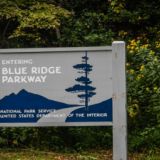Great Smoky Mountains Rainbow Falls Trail Reopens

Rainbow Falls trail is one of our favorite routes to the summit of Mount LeConte with a beautiful waterfall as a bonus!
Great Smoky Mountains Rainbow Falls Trail Reopens. After two diligent work seasons, the Rainbow Falls Trail has reopened! From May through November in 2017 and 2018, the 6-mile trail that accesses popular Rainbow Falls and the summit of Mt. LeConte has been closed Monday through Thursday to accomplish much-needed rehabilitation. Great Smoky Mountains National Park hosted a ribbon-cutting event to thank the work crew, volunteers, park partners, and donors for their support of the project. The event recognized the National Park Service Trails Crew, the American Conservation Experience Youth Crew, Friends of the Smokies, and the Aslan Foundation.
“We are pleased to announce the completion of renovations to the popular Rainbow Falls trail,” said GSMNP Deputy Superintendent Clay Jordan. “The improvements will be enjoyed today, tomorrow and next year by the park visitors, their children and grandchildren.”
In 2012, Friends of the Smokies established the Trails Forever endowment thanks to a matching gift from the Aslan Foundation in Knoxville. The $5 million endowment funds a full-time trail crew in Great Smoky Mountains National Park to reconstruct and rehabilitate some of the park’s most impacted trails.
The Trails Forever program provides the opportunity for highly skilled trail crews to focus reconstruction efforts on high use and high priority trails in the park including Rainbow Falls Trail and the recently restored Alum Cave, Chimney Tops, and Forney Ridge Trails along with other projects across the park. The program also provides a mechanism for volunteers to work alongside the trail crew on these complex trail projects to assist in making lasting improvements to preserve the trails for future generations.












